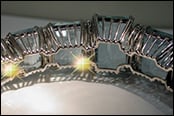Laser Welding Silver Jewelry
When laser welding, silver doesn’t play nice. This metal is going to fight you every step of the way, so you have to know how to fight back. Silver’s reflectivity and surface tension make it more challenging to laser weld than other precious metals, but there are tricks you can use to tame the beast.
Mask its reflectivity. “Laser welding silver is similar to hitting a mirror with light,” says Giles Pope, director of education for LaserStar Technologies in Riverside, Rhode Island. “Do not polish it before welding; leave the piece tarnished. Rough up the area that’s to be welded by sandblasting, using an emery board, or use fine grit sandpaper. Or you can mark the area with a Sharpie to allow the energy to go into the metal.”
 While laser welding if you find that you are having success in some areas of a piece but not others, try wiping your finger across the weld zone. “The oil and dirt from your finger will cut down on the reflective nature of the silver,” says Bob Staley of Bob Staley Jewelry Artisan in Cartersville, Georgia.
While laser welding if you find that you are having success in some areas of a piece but not others, try wiping your finger across the weld zone. “The oil and dirt from your finger will cut down on the reflective nature of the silver,” says Bob Staley of Bob Staley Jewelry Artisan in Cartersville, Georgia.
Use the right settings. The only way to break through silver’s surface tension is by using optimal settings on your laser welder. “The machine must be capable of 6 or higher kilowatts of peak pulse power for silver,” says Pope. And it generally takes longer to weld silver than gold or platinum. Pope suggests using 1.5 to 2 hertz and keeping the heat on the piece while you are working. “Avoid stopping and starting because the piece will lose heat, which is necessary for metal flow,” he says.
But take extra care when welding a silver piece with gemstones, due to the metal’s need for a lot of heat. “If the piece has stones in it and becomes hot in your fingers, you need to take a break, let it cool, and then come back to it to protect the stones from excessive heat,” advises Rod Stark of Stark Jeweler in Mountain View, Arkansas.
Choose welding wire wisely. Both Staley and Gary Dawson of Gary Dawson Designs in Eugene, Oregon, advise using a sterling silver welding wire with 5 percent platinum content when laser welding silver. “This is my absolute number one tip for laser welding silver,” says Staley. “This wire welds beautifully, and the weld holds nicely and doesn’t have porosity.”
Consider the work piece. Because every job has different requirements, choose your laser welding approach based on the work piece. For example, with a repair, you may want to take a few low-power test shots on the joints before starting work, suggests Stark. “Older silvers and their solders can be of different alloys with a lower melt temperature, and the standard setting could blow a hole right through it, maybe destroying a stone beneath it, or splatter back and make a mess,” he warns.
When working on a thin piece of silver such as a box chain, the roundness of the wire will take more heat than the flat sterling on the box chain, and the chain will melt before the welding wire. Stark suggests flattening the welding wire thin so it has the same melt temperature as the chain.
For sizing a ring, Derek Katzenbach of Katzenbach Designs in Farmington, Maine, advises chamfering the edge where the two sides meet and filling in the area with welding wire. “Otherwise it have a hollow seam and break later, particularly the next time you hit it on a ring mandrel,” he says.
This article was written by Shannon L. Brown, MJSA Journal, MJSA Tech Sheet, No. 35.
To learn more about laser welding jewelry, learn more about our iWeld Laser Welding System. The iWeld is our best selling laser machine in the jewelry industry. Download our iWeld Brochure Now.


